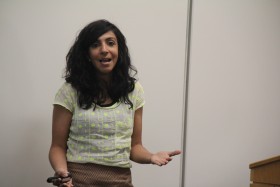There is no question that diseases have changed the course of humankind. Recent news stories about Zika, AIDS, and SARS show that disease is still a pressing public health concern. Like terrorism, disease does not respect political boundaries. Yet, those boundaries determine one’s likelihood to get a disease.
This distinction is what draws political scientists to study diseases, and was the focus of the October meeting of the Brown/Harvard/MIT Joint Seminar of South Asian Politics. Prerna Singh, Mahatma Gandhi Assistant Professor of Political Science and International and Public Affairs at Brown University gave a talk titled ‘New Potions in Old Bottles: Explaining the Differential Control of Smallpox in 19th Century Canton and Calcutta.’
Singh’s talk focused on this research question: Why have polities with similar epidemiological, socioeconomic and demographic conditions been characterized by strikingly different levels of effectiveness against disease? Singh focused on comparing how subnational and national units in China and India from the nineteenth and twenty-first century fight diseases. Specifically, she focused on the control of smallpox in the cities of Canton and Calcutta.
Singh explained that she chose to focus on smallpox because it is one of the oldest and deadliest diseases in human history, and has significant geopolitical importance. Its presence can be traced in the decline of Athens, the Roman empire, and the New World. It also has contemporary importance – the WHO considers its eradication the “world’s most triumphant achievement in medicine and public health.” The discovery of the smallpox vaccine was a public health landmark. Nevertheless, many countries still fear it as a bioterrorism agent.
Canton and Calcutta were two of the largest cities in the world at the time, and also had similar geographic, demographic, socio-economic, political, and epidemiological conditions. Singh found that by 1850, after the introduction of the vaccine by the East India Company, over 85% of the population in Canton was vaccinated, compared to about 1-5% in Calcutta.
Using theories from communication and cognitive psychology, Singh explained that biomedical technologies against a disease rarely exist in a void. Instead, when a new biomedical technology such as a vaccine or anti-retro virals are introduced a community, they frequently encounter competition with a range of long-standing ritual, cultural, and indigenous medical beliefs and practices, which can be impediments to adaption of the new technology.
Singh argued that in order for technologies to be received more positively, they should be embedded within existing cultural understandings of the disease. The main takeaway for political scientists and public health professionals is that people are more likely to adopt a new disease-controlling technology when it is presented within, rather than as a radical break from, familiar cultural and medical understandings.
The next Joint Seminar on South Asian Politics will be on Nov. 18 with Simon Chauchard: Who Influences Voters in Rural India? An Experimental Approach

